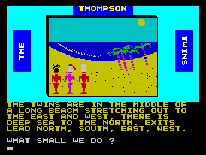
I have to avoid casinos, because I love blackjack — and despite my laughable attempts to devise “a system”, get fleeced within an inch of my life at least half the time. Why do I do it? Indeed, why does anyone gamble? Given that gambling revenues are, in one of our age’s typical ironies, increasingly providing a local tax base for motherhood stuff like hospitals and schools, we probably ought to be glad that fools like me are occasionally bit by the gambling bug. But anyone who gambles knows that it’s almost impossible to explain the attraction to those who don’t.
Over at the Culture Raven blog, my friend Erik wrote a short review of Frederick and Steven Barthelme’s Double Down: Reflections on Gambling and Loss, a memoir of their years spent flushing their professorial salaries down the toilet that is the Mississippi casino circuit. Their descriptions of the weird ecstasies of gambling are superb:
The possibility of perfection was something most of our friends and colleagues at the university where we worked no longer believed in. They had grown up, become wise, accepted things as they were. But everybody in the casino believed. However crude, however, dizzy, however self-deluded these people may have been, they knew how to hope, how to imagine life as something other than a dreary chore. They imagined that something wonderful might happen, something that could change their lives. This was their fool’s secret, one they shared with drunks, artists, and children, all of whom they resembled.
Cool enough, but Erik takes it up a notch by comparing the Barthlemes’ description of their inner states with Roger Callois’ theory of “delirium” in play. Play is, after all, a sort of social anarchy — part of what makes play fun is the sense of careening around inside a system and enjoying the chaos created by its simple rules, whether that’s hockey, Counterstrike deathmatches, or hopscotch. But Callois mostly talked about this delirium as an offshoot of intense physical play; Erik points out that the cool thing about the Barthelemes’ book is that it shows how this state can emerge even in the entirely interior headcase mental space of a gambler:
Caillois and those who follow him direct their attention to forms of play where physical activity is at its peak. They rarely attempt to analyze the delerium that possesses gamblers who, aside from getting the flop sweats or staring vacantly with dilated pupils, appear completely focused on the mechanics of the game. The Barthelmes, like Dostoevsky, make up for the omissions of the scholars.
Damn, now I feel like taking the bus down to Atlantic City and playing a few hands of Texas Hold ‘Em.

“Joey the Intern” at TechTV recently realized something interesting: When a disposable camera charges its flash, it uses a capacitor capable of generating 6,000 volts of electricity. So he ripped it open, attached a few electrodes, and voila — a do-it-yourself stun gun.
This is what my arm looked like the morning after I was shocked by our clever device. The two little red marks in the circle are burns I got. Being on the receiving end of that glove was not a day at the park.
(Thanks to Boing Boing for this one!)

Some Scrabble decks suck. Some suck a lot. And some are evidence that God personally hates you.
From the Bad Scrabble web site:
The following pages are real, unmanipulated examples of Scrabble-tile-chooosing ineptitude, hands so mind-bogglingly unfair in their horribleness that pictures just had to be taken. If you, or someone you know, has been involved in a similar incident, please submit your own photographs of Bad Scrabble Hands to our growing archive. Your help is much appreciated.

Any self-respecting geek in his 30s — and, yeah, okay, sure, I’m giving away my demographic a little bit here — has long been an expert in the art of locating a good game room while you’re on the road. When you’re stuck in an international airport waiting a red-eye, there are few better ways to dull the existential pain of life than to blow the hell outta green-blooded aliens in a nice stand-up cabinet edition of Area 51. Or perhaps re-sample the utterly sisyphean delights of Ms. Pac-Man. (Or perhaps muse on the next super-fey comment for your blog. Hey, how about that, asshole? “Sisyphean”? Get over yourself.)
Anyway. While there’s no joy so subtle as a well-stocked game room, the sad fact is most of them are horribly neglected. Many are the times I’ve hopefully wandered into a hotel game room, only to discover a sordid collection of the lamest possible games in existence, like Superman or Altered Beast or whatever. But clearly I’ve never hit the true bottom of the barrel. Over at X-Entertainment, Matt has discovered what is surely “The Worst Game-Room Ever”, complete with pix. I quote:
The evil game room, save for two newer soda machines, doesn’t seem to have had any renovations for nearly a decade. Hasn’t been cleaned, either. In a place like Atlantic City, where every footprint is marked by residual puddle water and dog shit, the fact that the game room hadn’t been vacuumed since 1971 puts it at the mound with one strike already against it.
Make sure you scroll down to see the pictures of the dispensing slot of the ice-cream machine. I still can’t eat.

A bunch of German scientists have developed a way for mobile phones to communicate messages by touch: A set of pins that rises and falls would transmit information, kind of like braille. They don’t actually use braille, mind you. Their system is intended to communicate simple types of messages to a mobile phone user, so that they could receive messages on the sly. If you were in a meeting, you wouldn’t need to actually pull out your phone and look at it — you could just stick your hand in your pocket, feel your phone, and figure out that your spouse was texting you. As the BBC reports:
For instance, the ‘@’ sign might feel like a spiral, the word ‘I’ as a wave that flows towards the person and ‘you’ as a wave that flows away.
I love this idea. It’s part of the (hopefully) growing trend towards “ambient information” — devices that communicate information in the peripheries of our attention, as opposed to forcing us to stare at a screen. If you’ve ever seen the Ambient Orb — produced by the insanely brilliant David Rose and his team at Ambient Devices — you know what I’m talking about. Indeed, one of the most elegant pieces of ambient-information design I’ve seen are the psychoacoustics of America Online’s Instant-Messaging application. When someone on your buddy list logs on, you hear the sound of a door creaking open; when they leave, the door slams shut. It’s a delightfully nonintrusive way to let you know that your virtual social-scene is filling up, without forcing you to continually click over to look at your buddy list.
A well-designed “touch and read” mobile phone could do the same thing: When you idly reached into your pocket to touch it, it could gently indicate some important information, without you needing to whip it out and stare at it.
I had no idea there was an entire category of high-tech cosmetic technology called the “facial gym”.
(Thanks to Gizmodo for this one!)
Three weeks ago, a self-described psychic called up the police to claim he or she had a premonition that a bomb would be on American Airlines Flight 1304. The airline cancelled the flight and sent bomb-sniffing dogs on board. They didn’t find anything, and as CNN reports:
The purported psychic’s call was “unusual,” conceded Doug Perkins, local administrator for the federal Transportation Security Administration director.
“But in these times, we can’t ignore anything. We want to take the appropriate measures,” he said.
My first reaction was, of course, what in hell is going on? Airline officials are halting entire flights because of a freaking psychic? But of course, there are good reasons for taking that type of call seriously — not least that the caller might be actually involved in the bombing themselves, ridden with guilt, and using this pretense as a way of letting the airline know what’s about to transpire. That’s a long shot, but if I were running an airline, I wouldn’t want to take the chance either.
(Thanks to Plastic for this one!)
Last week Slate published my latest column — which is an ode to streaming, that mostly-neglected way of getting digital music. I tried out the streaming service Rhapsody, and discovered that quite to my surprise, it rocked madly. With 500,000 songs instantly at my beck and call, for $10 a month, it suddenly became really easy to explore new artists — something that is incredibly expensive if you do it by buying CDs, and incredibly slow if you do it by using Kazaa. Most interestingly, I discovered that I didn’t really care that much about not “owning” the songs; I was willing to trade enormous access to a massive library in exchange for not actually having them, physically, on my hard drive. That’s partly because, as I noted, ownership these days isn’t actually ownership:
But as music fans are finding out, when you buy a song online, it usually isn’t property any more. It’s a license, an agreement to let you use the song. And those licenses impose some maddeningly Byzantine limits on how you use your music. Most legal downloads will work only on approved devices. A song bought at iTunes in “AAC,” or Advanced Audio Coding, format won’t work on anything but an iPod, while songs bought at MusicMatch or Napster in Microsoft’s “WMA,” Windows Media Audio, format won’t work on iPods or many older MP3 players. And what if you get bored of that Strokes album you downloaded? Too bad: You can’t sell it to anyone. That, too, would violate most of the licensing agreements. Worst of all, licenses on downloaded music can be rescinded. If the music companies want, they can “turn off” your right to listen to the music you’ve bought.
By using licenses, the labels and their download sites are secretly transforming music into a service—something to which you subscribe, and about which they can change the rules any time they want. But it’s a particularly crappy service. Who wants to “own” this sort of pseudo-property, these annoying, stubborn, mulelike music files? In contrast, a music-streaming site advertises itself as a service, with an entirely different sort of consumer logic and much more satisfying results.
You can read the entire piece online if you want here! And if you post any comments in the message boards here, copy ‘em to the Slate Fray, where intelligent comment is always welcomed.
Today in the New York Times’ Arts & Ideas section, I have an article about John Rummel, NASA’s “planetary protection officer”. He’s the guy who makes sure that our space probes are sterilized as much as possible — so that we don’t accidentally send Earth microbes to Mars and seed the red planet with life. “The best way to find life on Mars is to bring it from Florida,” as Rummel puts it. But sterilizing a spacecraft is hellaciously difficult. Among other things, it requires baking the component parts in a 233.1-degree-Fahrenheit oven — which, of course, also requires you build the components so strong that they can endure being baked in an oven. Ever tried putting your Dell in the stove?
The upshot, as I discovered, is that the very concept of planetary protection is somewhat controversial amongst space buffs. Because protection requires such care, it slows down the pace of space exploration considerably. At the nut of it is the following paradox:
At its heart, though, planetary protection is a weirdly philosophical task, simply because there is no proof that life exists anywhere else. What precisely are we protecting against? Mr. Rummel will bend over backward to keep alien life from harm, while cheerfully admitting he is not sure there actually is any. Planetary protection is thus like an Xtreme form of environmentalism. When Galileo finished its mission to explore Jupiter last fall, NASA chose to destroy the probe by flying it into the planet, so it wouldn’t accidentally crash on Europa and infect it.
But this caution, Mr. Rummel notes, is not merely about protecting life. It is about protecting science. If a probe were to accidentally seed Mars with Earth microbes, scientists might later mistake them for natives. “The point is to be able to tell” that there is nothing there, he said.

One of my favorite things about robotics hobbyists is that they’re always driven by one overwhelming goal: To create a robot that can serve them a beer. The closest we’ve come so far is the Androbot, sold back in the 80s, which came with an “Androfridge” attachment so that it could carry beers to you as you rot, senescent, on your barcalounger.
But now Brian Pietrodangelo, a student at the Univerity of Florida’s Machine Intelligence Laboratory, has created Koolio — a “travelling autonomous refrigerator robot”. Anyone at the Lab can order a drink online and Koolio will deliver it. This requires a terrific bouquet of navigation techniques, including:
- Sonar for accurate long distance coverage.
- IR for close obstacle avoidance.
- Shaft encoding for accurate navigation once location is determined.
- Web cameras for reading room numbers off the wall.
(Thanks to Slashdot for this one!)
Ever wished you could start your life fresh? Some guy in Raleigh has decided he wants to reboot his existence, so he put up his entire life’s possessions on Ebay for $300,000:
I’m starting from scratch. Mid-life change in philosophy. I’m selling everything I own and starting over again: house, vehicles, all furnishings, antiques, specialty construction tools and supplies from my former life as a general (utility)contractor … Determined to redirect the second half of my life and live in quiet simplicity with the woman and love I have finally found. After 40 years racing to acquire more stuff, I’m going to get rid of it all as quickly as I can and take a more deliberate approach to life.
As you can imagine, there’s a sort of existential problem here: If you’ve decided your life sucks and you want to get rid of it — that’s not really the most enticing sell line, is it? After one week, the auction ended, with nary a single bid.
(Thanks to Rummaging for this one!)

Scientists have found that dust devils can be highly electrified. Apparently when all that dust is whirling around, it creates static electricity; then tiny particles that absorb negative charge tend to rise, leaving the positive ones lower down — turning the whole thing into a big battery. When researchers have driven through dust devils in the Nevada desert, they’ve found electric fields as badass as 4,000 volts per square meter.
So now NASA scientists are wondering what this bodes for Martian probes and manned space exploration. Mars has dust devils too — in fact, the Pathfinder probe took a picture of one in 1997 (!) — so NASA geeks are already writing papers about it, as CNN reports:
“If Martian dust devils are highly electrified, as our research suggests, they might give rise to increased discharging or arcing in the low-pressure Martian atmosphere, increased dust adhesion to space suits and equipment, and interference with radio communications,” said William Farrell of NASA’s Goddard Space Flight Center.
Man, I love NASA. Guys get paid to sit around studying this stuff! Then again, when you’re sending billions of dollars of robotic equipment millions of miles through space, you want to think of every conceivable danger — even if that includes possibly electrified Martian dust devils.
Here’s a weird bit of pain research: A scientist claims to have shown that people feel more pain if the person inflicting the pain is a man.
David Williams of the University of Westminster set up an experiment that wouldn’t have been out of place in the Spanish Inquisition: He had students put their fingers in a clamp, and then had other students twist it tighter and tighter until the pain was unbearable. The result? The subjects allowed women to twist the clamp much further than men. As Williams told the BBC:
“This effect is likely to be a result of what participants subconsciously expect, based on socially acquired gender stereotypes — people feel that they are less likely to experience intense pain from a stimulus given by a woman rather than a man.”
You can read more about his argument in the university’s press release. His results seem very intriguing, though I’m not too sure about his conclusions; whenever scientists start generalizing about how “women are this way and men are that way,” I always suspect (maybe unfairly in lots of cases) that they’re wheeling their own full set of Samsonite baggage onto the tarmac.
(Thanks to John for this one!)

It appears the trend of using video games as a form of political commentary has now spread as far as the Republican party. Recently, they’ve been releasing a series of pretty funny little games attacking Kerry. One of them is John Kerry: Tax Invaders, in which you use George Bush’s head to shoot a series of tax increases that come looming from the sky. (The graphics are incredibly bad, but, rather mindblowingly, the opening screen briefly samples the beeyoo sound effect of a missile being fired from the original Space Invaders.)
Rather more interesting is the game Kerry vs. Kerry. In it, you get two Kerry boxers to punch each other by pushing each’s button — one of which is entitled “flip”, and the other “flop”. When you hit one, the first Kerry will land a punch and the game will say something like “For Iraq War”; push the other button, and the other Kerry says “Against Iraq War”. Laffarific enough, but the cool part is that each punch — for or against the war, or whatever issue upon which Kerry flip-flopped — has a link: Click on it, and it’ll take you to a GOP page where they describe the specifics of Kerry’s seemingly-contrary positions. Now that is actually a kind of clever use of gaming as rhetoric.
(Thanks to Ian for this one!)

If you’ve ever sat in a cafe trying to wifi, you’ve probably noticed the often-witty names that people give to their wifi hotspots. (At the cafe near my place in the West Village of Manhattan, there’s a wifi node called “slut hut”.) Julian Bleecker, a technology designer, has come up with a brilliant idea for an art project: He’s going walk around New York with an application that will sniff wifi hotspots, read their names, and compose haiku from them. An example from his website:
gina network - piss
off, my girlfriend can snowboard
jeepyland, NetHome
If you’re in town on May 13 and 14, you can hang out with him while he roams the city! Check out details here. And while you’re at it, note that Julian’s project is part of the overall “psychogeographic” art festival happening in New York that week — filled with oodles of other projects that blur the boundary between data and the physical world.

For the first time in 60 years, Morse code is getting a new character — the “@” symbol. It seems that in the age of the Internet, ham radio enthusiasts who use Morse have been trading email addresses. But the standard Morse alphabet didn’t have designation for @, which meant they had to improvise. As the New York Times reports:
Until now, those ham operators had to spell out @ with two letters of code: “A,” a dot followed by a dash, and “T,” a dash. The resulting sound is “dit-dah-dah,” which also translates to the letter “W.”
To stop the madness, the International Telecommunication Union is officially approving a dot-dash string to represent @: dit-dah-dah-dit-dah-dit. It’s a combination of the letters “A” and “C”, and has a unique sound; it can’t be confused with any other single character.
But there’s a problem …
“The irony is that sending the word ‘at’ is shorter,” Mr. Lindquist said.
By about half. Each dash is three times the duration of a dot, and within a single character, the space between sounds is one dot long. So, the word ‘at’ takes nine beats, or dots; the @ symbol takes 17.
The result? Of the Morse freaks that the Times spoke to, most said they wouldn’t use the new character; they prefer their grassroots tradition of spelling out “at”.
It reminds me of how France is always trying to purify their language by developing officially “French” versions of English phrases and slang that creep into the popular argot. A while back, their language cops decided they should give the @ sign a French name, and proclaimed it the “arobase”. But few people use these made-up official words, because that’s not how language grows. It evolves organically — a bunch of hacks and kludges duct-taped onto tradition, with no governing body approving anything at all.

Levy Lorenzo, a student at Cornell University, has created a MIDI device where the various parts of the song are controlled by hamsters. He describes it on his web site thusly:
Guided by inputs based on hamster movements, Markov chains were used to perform such beat and note computations. In culmination, 3 simultaneous voices were produced spanning 3 octaves and 3 rhythmic tiers. Each voice was controlled by two hamsters: one that was responsible for adjusting the rhythmic qualities of the melody and another that modified the note sequence. With all of these elements in combination, an output was produced with very musical qualities.All of this was implemented using an Atmel Mega32 microcontroller, distance sensors, a HamsterMIDI Controller, and 6 hamsters. Embedded C programming implemented the algorithms and computations within the sequencer.Overall, this project was successful. The control between the hamsters and the musical intelligence turned out very well.
There’s a video of the hamsters playing the music, which may be the most delightful thing I’ve ever seen in my entire life, anywhere. And you know what? The music ain’t half bad! Granted, MIDI being MIDI, it’s not hard to pick a bunch of samples and melodies that inherently sound nice together; in a sense, it seems like the hamsters act mostly as faders, bringing the various constituent parts in and out of play. Either way, I’ve now put an MP3 of this on my main playlist in my player.
(Thanks to Boing Boing for this one!)

This rocks beyond description. An international gang of artists is going around the world’s major cities and surreptitiously installing little versions of the Space Invaders aliens — rendered as ceramic-tile art! That one above is in Notre Dame, but there might be ones near you: Check their web site for pictures of the installations in different cities to find out. I personally am going to try and visit all the ones in New York.
The photos are quite hilarious — the aliens manage to look both pop-culture cheerful, and occasionally kind of doubtful, as if they’re not really sure how they hell they wound up invading such a weird planet.
(Thanks to Kevan for this one!)

A surgeon in the Netherlands has developed a technique for implanting decorative jewelry inside your eyeball. As MSNBC explains it:
The procedure involves inserting a 0.13 inch wide piece of specially developed jewelry — the range includes a glittering half-moon or heart — into the eye’s mucous membrane under local anaesthetic at a cost of $610 to $1,232.
“In my view it is a little more subtle than (body) piercing. It is a bit of a fun thing and a very personal thing for people,” said Gerrit Melles, director of the Netherlands Institute for Innovative Ocular Surgery.
Okay, the modern primitive movement is officially over. Clearly, Middle America has so openly embraced the supposedly-alternative world of body art that even the fucking Dutch are cutting themselves open in an attempt to stay ahead of the hipster curve.
This reminds me of an idea I thought of a while ago: Internal Tattoos. The pitch would go like this:
Dude! Want to stick it to the man with some consumption-as-rebellion — but afraid that tattooing is getting too mainstream? We’re with you, brother! Now that every Jenni and Robyn at the local sorority has a butterfly smeared on her ankle, that ink you had done back in ‘94 — you know, the Chinese pictogram for “resist” on the back of your neck — just doesn’t have the same subcultural frisson. It really sucks.
But hey! We’re here to drag you one step ahead of the pack again — because we’re offering internal tattoos. That’s right: Tattoos inside your body. We’ll open you up surgically, tattoo your desired pattern on any one of 17 major organs, then sew you back up again. Nobody will be able to see your tats — but that’s the point! Read the memo, man: Visible-skin tattoos are over. But you don’t care. No you do not! You’re surfing the edge again! With a super-ironic LIVE FREE OR DIE etched onto the surface of your pancreas, you’ll be sporting a tattoo so extreme we’ve dropped the capital X. Call now. Operators are standing by.
Holy shit am I ever a crank.
(Thanks to Rummaging for this one!)
You know those high-flying CEOs who get free use of the corporate jet, even for personal reasons? We’ve all envied them. But maybe we ought to be doing something else — like dumping their stock.
New York University professor David L. Yermack recently crunched numbers on 237 large companies. He found that companies that give their CEOs free personal jets perform worse on the stock market than those that don’t. It is, he says, a “dramatic, almost shocking” link — and seems to be driven by investors’ disapproval of the perk. As the New York Times reports:
When companies start disclosing that they have extended this perquisite, he said, their shares drop 2 percent, on average. Then they underperform their market benchmarks by more than 4 percent a year, what he called “just an enormous gap.”
Mr. Yermack likened the effect to what might happen when a high school student gets his first car and, intoxicated by the freedom it affords him, stops studying and falls off the honor roll.
He said he believed speculators could profit simply by betting against companies that invite their C.E.O.’s to steer clear of crowded airports. “If you sold short companies that give this perk and bought all other companies, you would really clean up,” Mr. Yermack said.

CNN is running a story about Orbital Development, a company that is offering to crash 22 pounds of personal cargo into the moon for about $6 million.
That’s not as far-fetched as it sounds. Back during pre-Apollo days, the Soviets and the American would regularly smash stuff into the moon as a way of testing how viable a human moon-shot would be. The end result is that rockets with moon-reaching capacities are now suprisingly cheap over in Russia, and Orbital Development plans to use them. But one question yet remains: What’s the target audience here? As CNN reports:
Gregory Nemitz, president of Orbital Development, said: “The MoonCrash Project would probably be attractive to some bored rich guy, who is tired of playing with his radio-controlled model airplanes and wants to move up to the next level.”
Well, when you put it that way — sure, yeah, there probably are rich dudes willing to blow six million bucks flying their dirty socks or their poodle’s cremated ashes to the moon. But the bigger question is, is Orbital Development for real? If you go to their site, they seem to be interested not so much in flying stuff to the moon but in selling beef jerky. I’m not kidding about that.
(Thanks to Slashdot for finding this one!)
My friend Erik of the Culture Raven blog just did a hilarious translation experiment — he rendered a chunk of Shakespeare’s Twelfth Night into texting shorthand. Check out his entry and you can compare his revision against the original Shakespearean text:
DUK RSNO
1s mor, Cesario, gt thee 2 yond same sovereign cruelty: tel her, my lov, mor noble thN D wrld, Prizes nt qty of drty lands; D parts dat fortuN hath bestow’d upon her, tel her, I hld as giddily as fortuN; bt ‘tis dat miracL n queen of gems dat nature pranks her n attracts my soulVIOLA
bt f she cnot lov U, sir?DUK RSNO
I cnot B so ansDVIOLA
Sooth, bt U must. sA dat sme ldy, as praps der S, Hath 4 ur lov a gr8 a pang of <3 As Uv 4 Olivia: U cnot lov her; U tel her so; must she nt thN B ansD?DUK RSNO
there’s no woman’s sides cn bide D beatN of so tuff a pa$N As lov doth giv my <3; no woman’s <3 So big, 2 hld so mch; dey lack retention. Alas, their lov may B call’d appetite, No motion of D liver, bt D palate, dat suffA surfeit, cloyment n revolt; bt myn S ll as :o9 as D sea, n cn digest as mch: mak no compare btw dat lov a O+ cn bear me n dat I O Olivia.VIOLA
Ay, bt I know—DUKE ORSINO
w@ dzt thou knw?VIOLA
2 wel w@ lov women 2 men may O: n faith, thr as tru of <3 as we. My dad had a dautA luvD a mn, As it mYt B, praps, wr I a O+, I shd ur lordship.

French authorities have finally located the remains of the plane that Antoine de Saint-Exupéry was flying when he crashed. Saint-Exupéry was most famous for writing The Little Prince, but he was also a bit of a steampunk geek: He was a hard-core aviator and had a sort of zenlike attitude towards machinery. The folks at Snarkmarket found an excellent page of quotes from him, including this one:
The machine does not isolate us from the great problems of nature but plunges us more deeply into them.
(Thanks to Snarkmarket for this one!)

This is excellent — a version of Joust, played with various political figures in and around the Bush/Kerry race! You can pick either side, but either way, the figures shout hilarious little one-liners that are composited from statements that were actually uttered. I played as Kerry, who flew around saying “War. Hero. Me!”, and at one point had to fight Rush Limbaugh, who babbled about how stoned he was.
Apparently if you play really well, you can get extra powerups including “Patriot Missiles” and “WMD stockpiles”.
(Thanks to Water Cooler Games for this one!)
If you were intrigued by the piece I wrote for Slate yesterday on gay marriage in video games, check out today’s fraywatch — a compendium of interesting conversations happening inside the Fray, Slate’s discussion board. Today, it pulls together the threads devoted to my gay-marriage column.
This is cool: An online calculator where you can figure out just how badly you’d die if a meteor hit the earth near you. You plug in how far away it would hit, what type of meteor — “ice”, “porous rock”, “dense rock” or “iron” — as well as the speed it’s travelling and the angle of impact. Then click the button and, presto: The details of your own private eschaton.
I set it up for a half-kilometer-sized ball of ice, hitting the earth at a 35-degree angle and travelling 10 kilometers per second. The result? It would release 3.27 x 1018 Joules of energy, roughly equivalent to 7.82 x 102 MegaTons TNT, leaving a 5.2-km-wide crater. It would create a 6.5-Richter shock wave, and the “ejecta” — stuff thrown in the air — would hit 45 seconds later, with the chunks each being 12 feet in diameter.
The worst part? The “thermal radiation” cast by an object superheated as it ploughed through the atmosphere at such an awesome pace. The fireball would be 67.3 times larger than the sun, and would cause the following damage:
Much of the body suffers third degree burns
Newspaper ignites
Deciduous trees ignite
Grass ignites
Nice. Thank god this sort of impact apparently only happens every 19,000 years.

For hundreds of years, mathematicians have sought for a proof to the orange-packing question. That question is thus: What’s the most efficient way to pack oranges? Most people would assume it’s in the pyramid shape, but it was fiendishly hard to create a mathematical proof.
In 1998, the mathematician Thomas C. Hales finally created a proof, but it had a big problem: It hinged upon a bunch of insanely complicated computations done by computer. It has created a sort of culture clash in science, because, as the New York Times reports:
Believing it thus, at some level, requires faith that the computer performed the calculations flawlessly, without any programming bugs. For a field that trades in dispassionate logic and supposedly unambiguous truths and falsehoods, that is an uncomfortably gray in-between.
It’s a really interesting piece, and it throws to a lot of other disciplines too. Economics, census work, and even quite a bit of straight-ahead politics now relies upon computations that are not really checkable by humans.
(Thanks to Slashdot for this one!)

The mathematician Stan Wagon has created a bicycle with square wheels. It doesn’t work on flat land, of course — but it rides perfectly when you roll along a road made of of “catenaries”. And what the heck is a catenary? Glad you asked! As a story about the bicycle notes:
A catenary is the curve describing a rope or chain hanging loosely between two supports. At first glance, it looks like a parabola. In fact, it corresponds to the graph of a function called the hyperbolic cosine. Turning the curve upside down gives you an inverted catenary—just like each bump of Wagon’s road.
The thing is, you can create a catenary curve by spinning a square on its axis and tracing the trajectory of a point. That’s a little hard to visualize, but if you go to that page, there’s a cool animation showing how it works.
One of the great Turing moments in the modern world is when you have to deal with a voice-mail system that has been programmed to “behave” like a real person. Depending on how good the voice-acting is and how seamlessly the voice prompts queue up, it’s sometimes possible at the outset of the call to fool people into thinking there’s a real person on the other side. But most people these days are so good at detecting faux-humanity that voice-recognition companies have had to adapt to our enhanced Turing abilities.
David Holsinger, a linguistics expert, has written a fun blog entry describing the pendulum swing that’s taken place in recent years. Voice recognition companies found that two things were happening:
(1) people were so completely fooled into thinking that they were talking to a human that they responded in ways no speech-rec application could ever be built to handle (try matching an utterance like, “Well, howdy! Sure thing — I’m just trying to figure out how many minutes I got left on my phone!”)
(2) the more common response — no one was fooled, and people reacted with equally unparseable globs of “command words,” and frequently words clearly influenced by the predominant visual metaphors in computing: “Clear!” “Restart!”
Obviously, no human interaction has ever included the phrase “Ok, your order comes to $21.99” followed by “No! CLEAR!” Realizing this, voice user interface designers seem now to be dragged by a slow and painful pendulum swing back in the other direction, towards the converational style of “To clear your last message, press STAR-STAR.” … The curtain is up — our users always knew that there was a machine back there, and dammit, they want to treat it like any good machine — by yelling at it in monosyllables.
The interesting thing is that ‘bot manufacturers tend to assume there are only two different type of service ‘bots: i) Ones that can fake you into thinking they’re real, and ii) ones that fail — and are too easily detected as human.
I think there’s another category: iii) The robots that where you know they aren’t human, but don’t care, because they’re robotic in an interesting way. To me, the best robots are like R2D2. They do not try to be human; indeed, they’re explicitly robot-like, and by being robot-like, are actually far more charming than faux-human ones. A good physical example of this is the Roomba: It’s not human-like at all, but because it looks so funny and self-aware as it zips around the room, one tends to treat it as “alive”.
In the voice-prompt world, there’s Wildfire, a voice-activated personal assistant. It doesn’t seem particularly lifelike, but the acting was done by a woman with such a gorgeously husky voice that several male executives I knew used to sit around asking her the time over and over again, to enjoy the sound of her whispering in their ears.
Slate just published my latest video-game column — which is about the trend towards incorporating gay marriage into video games. It starts off talking about a recent Atari game, The Temple of Elemental Evil, which allows two male characters to wed. Then I ask:
Video games have long allowed players to experiment with new and often taboo identities. In online games such as Everquest, almost half of the women characters are actually men—guys who prefer to cross-dress when they play. In the ’90s, Tomb Raider and its imitators were so popular that for several years, American teenage boys played almost exclusively as buxom, wasp-waisted women. But for young men, the bulk of these games’ audience, experiencing life as an ass-kicking action chick is probably less threatening than adopting the role of a homosexual man. The new generation of gay-positive games presents an interesting test of how far role-playing can stretch. Will straight gamers want to play at being gay?
You can read the entire article online at Slate! If you have any thoughts to post here on my blog, take a few seconds and paste ‘em also into the Slate discussion area The Fray, where smart comments are always welcomed.

For years, video-game designers have been the world’s masters of interface design. After all, games are pretty information-heavy. When you’re running around in Counterstrike or Everquest, you’re trying to keep track of your weapons inventory, your place on the map, your comrades, and the action happening right in front of you. Game-makers are so good at presenting information they’re practically Edward-Tufte-class.
But one of the best ever is undoubtedly Will Wright. When you build a ‘burb in SimCity or a house in The Sims, the interface is a masterpiece of elegance and intuitiveness: Each quadrant of design clicks neatly into the next, like lego bricks of reality.
It’s so good, in fact, that companies are actually plundering Wright’s style in advertisements. Check out this TV ad by energy company Areva: There’s a still image above, but if you go to the site and click on “The Ad Campaign,” you can view the entire TV commercial. It looks almost precisely like the interface for a Sim game, right down to the tiny dancing people.
NOTE: Check out the discussion of this item — folks have posted several links to very cool other examples of this genre, including music videos done with this visual style!
(Thanks to Michael for this one!)
I studied political science and English at college, and frequently had to deal with people asking me, “but what use is it?” I never had a particularly pithy answer until I read a recent essay by Ian Bogost — the cofounder of Water Cooler Games, a blog devoted to video games as social commentary — over at the International Game Developers’ Association site. He’s writing about “The Muse of the Video Game,” and explaining why the social sciences are useful not just in designing games, but in life:
My colleague John McCumber, a professor with whom I taught at UCLA, has an effective response to the charge that the humanities are “useless”. Fields like business, medicine, and computer science seem “practical” because they are predictably useful. That is to say, we can know in advance how to reap immediate gain from them. By contrast, the humanities are unpredictably useful; we cannot know in advance how they might serve us. As the name suggests, the humanities help us understand what it means to be human, no matter the contingencies of profession, economics, or current affairs. The humanities offer insights into human experience that we need when industries, militaries, governments, game engines, middleware and all else fails. This is the knowledge that helps us recover from heartbreak, to make sense of 9/11, to understand betrayal. It is this unpredictable usefulness, this postponed fungibility in the humanities that is so often mistaken for uselessness.
By now, you may have heard about Gmail, Google’s new email service. Part of what makes it cool is that Google is offering unusually large storage space — 1 gig per person, for free! That’s 500 times bigger than Hotmail, and it’s a brilliant marketing move. First off, it acknowledges that email these days often consists of rich-media attachments — audio or video files — that take up lots of space. Secondly, it recognizes that hard drive space simply isn’t very expensive any more; it’s about a dollar a gigabyte, a price that would easily drop in half if you bought in bulk, as Google would do.
Most importantly, it acknowledges that people want to save tons and tons and tons of mail. Indeed, our inboxes are often like filing cabinets for life — quick and easy places to access the documents and information we need, organized in that wonderfully human-scaled format, chronologically. I currently have over 4,000 messages in my inbox, the oldest of which date back three or four years. I don’t bother using an address book because I can instantly do a “find” in my inbox to find a message from someone with all their information in it; and since I use pine, my inbox is accessible from any computer worldwide. And sure, I’m nuts. But I think this idea — never deleting any important emails, and keeping them around forever — will become a much more common way of organizing one’s thoughts, as hard-drive space becomes ever cheaper. This is part of what I wrote about in my recent essay on “online honesty”: We are facing a world in which everyone will be remembering more and more, because there’ll be less and less reasons to forget things.
Ah, but what about when you want to forget something? What if you want to delete a message? What if you really need to eliminate something — for legal or personal reasons?
As it turns out, Google may not let you do that. Their terms of service warn that even if you delete an email, Google may still keep copies, “even after you have deleted them from your mailbox or after the termination of your account.” What’s more, Google is aiming to link together patterns in your web searching and your inbox, the better to deliver ads. Put together, this may constitute a breach of European privacy laws, as Reuters reported today:
“This is not just ‘buyer beware’. Consumers should be aware that there’s a vast violation of European law occurring here,” said Simon Davies, director of Privacy International, a citizens’ group with offices in Britain and the United States.
Europe’s privacy protection laws are much stricter than those in the United States, where Google is based. European consumers, for example, have the right to retain control over their communications.
“If a person deletes an email, he should be confident that email is actually deleted,” said Maurice Westerling, co-founder of Bits of Freedom, another privacy interest group, based in the Netherlands.
“Besides, Google cannot just open emails. Communication in Europe has a very high degree of protection.”
(Thanks to Slashdot for this one!)

This week, the New York Press published its annual feature on “The 50 Most Loathsome New Yorkers”, and while some of the nominees were the usual suspects — 50 Cent, Chuck Schumer, Dick Grasso — one of them was unexpected: The Ipod. Or rather, the people who use them — “i-Snobs”, as the magazine called them:
THE BLINDING WHITE cords flowing out of my sublimely waxed ears say it all: I’m in no mood for talking, and my income bracket makes cumbersome CDs so unnecessary, so Second Wave. With thousands of songs from my iPod at my polished fingertips, I can now walk through life effortlessly, angelically, shielded by the anodized aluminum of my futuristic listening device. I can strut with confidence and disinterest past those in my chosen path. I’m cut off from your dirty world by my ear buds and their enhanced sound and noise-suppression features. I’m a creature of advertising, a walking cliche with 25-minute skip protection and Volkswagen dreams. Shit, my profile even resembles the faceless, platonic form in the billboard.
I confess, this made me giggle a bit. Though I definitely see the attraction of the ipod, it’s also true — as I blogged a while back — that the ipod is not merely a music player. It’s a piece of existential performance art, a way of illustrating that you are such a musical aesthete that you need to have 10 bazillion songs at your beck and call every second of the day.
Interestingly, I may not be pulling this argument entirely out of my ass, since it appears that I’m supported by academic research. Michael Bull, a media lecturer at the University of Sussex, studies people’s uses of personal audio players; he wrote a book in 2000 called Sounding Out the City: Personal Stereos and the Managment of Everyday Life. He discovered, as you might imagine, that people use Ipods as a way of establishing control over their environments. In that sense, the wits at the New York Press are precisely right: Part of wearing an Ipod in public is about setting up a personal no-fly zone and publicly proclaiming you really do not want anyone to talk to you. It’s not much different from the way married women with children use romance novels: As ethnographer Janice Radaway argued in her superb book Reading the Romance, the women do not read the novels merely for their content; they read them as a device for alerting their families to piss off, because mom needs some quiet time to herself.
And as for those Ipods? When Bull similarly asked people how many songs users listened to, it turned out that — whoops — nobody really needed 10,000 tunes. The excess capacity is pure overkilll, because all the users were doing was looping the same few tunes over and over again as they zoned out the world. As Bull told Wired News:
I found that they use the same music on a regular basis. They will often play the same half-dozen tunes for three months …

Since NASA is too scared to send any astronauts up in the Shuttle, and since Bush has decided to sideline the Hubble, scientists are increasingly trying to figure out innovative ways to keep the thing running. The latest idea? Send up robots! From MSNBC:
NASA’s Goddard Space Flight Center in Greenbelt, Md., is now reviewing ideas from a variety of groups, including university and major aerospace firms. According to Space.com sources, Goddard has received 27 proposals ranging from a few pages to a 200-page tome from a leading aerospace firm.
I’m coming to this one late, but in case you hadn’t heard — during some of the crucifixion scenes in Mel Gibson’s christspolitation flick The Passion of the Christ, it was actually a $400,000 robot Jesus, because the weather was too cold for the actual actor to endure.
UPDATE: Ah, this was too good to be true, and I probably should have known. Reader Will noted in the discussion thread for this item that the robotic jesus is an urban legend.

Gravity Probe B is finally getting ready to launch — after 45 years. What, might you ask, is Gravity Probe B? Basically, it’s a really weird experiment intended to prove some aspects of Einstein’s theory of relativity.
One of Einstein’s predictions is that if you put an object in orbit around the earth, after a long enough time zipping around space-time, it would begin to experience a different orientation than the same object would if left stationary on Earth. Essentially, it’d have a different sense of “north”. It’s an effect called “frame dragging,” which you can now officially use to trump the pseuds at the next cocktail party.
The problem is, at satellite speed — which is way, way slower than the speed of light — the effect of frame dragging is incredibly minute. The shift in perspective for an object would be 1/3 of a milli-arc-second a year — which is, like, well, just kind of incredibly tiny. (It’s what a piece of hair would look like if you peered at it from 20 miles away.) So how do you measure such a tiny shift in degree?
With Gravity Probe B! It’s essentially an enormous flying thermos that contains four ping-pong-sized balls of quartz, which are the roundest things ever made by humans. They’re so smooth that the only thing rounder is a neutron star. As a cool story about Gravity Probe B puts it:
That’s equivalent to the Earth’s surface being polished so round that mountain peaks and ocean trenches are within 5 meters (16 ft) of the same level.

Michael Zalewski is an artificial-intelligence programmer who had a brilliant idea about chatbots. Most chatbots are limited by the fact that their creators need to laboriously tell them what to say; they try to anticipate everything you might say to the ‘bot, then program in a suitable response. So of course, the ‘bot can only grow as fast as a human can “teach” it. That’s why “knowledge bases” — the bits of chat and information a ‘bot has been endowed with — are so slow to evolve.
Zalewski realized there was a way to build a base much more quickly, if chaotically: To use Google. So he built a ‘bot called Catty, which listens to what you say, then scours Google to find seemingly appropriate text responses. There’s a more complex description of how Catty works here, but one of the interesting things Zalewski discovered is the paradoxical rule of chatbots: The more simple and stripped-down the ‘bot is, the more lifelike it’ll seem. That’s precisely the epiphany that made ALICE work so well, as I’ve written about ad nauseaum in the past.
Having said that, Catty doesn’t seem entirely ready for prime time. Here’s a sample of my conversation with her:
Me: Nice to meet you!
Catty: for neither can he that understands that understand anything else nor he that sees that see any thing else nor hear any other thing nor in sum move the body?Me: Okay, you’ve lost me.
Catty: okay i think i understand you better now and i can appreciate and just enjoy the give and take and the sexual energy thats going one right now?Me: There’s already sexual energy in this conversation?
Catty: many people are already doing some of the 8 points suggested in this lifestyle program :-(Me: Holy moses. You are like ALICE’s crazy sister.
Catty: i am like a hole in your shoe a breath of fresh air with every step you takeMe: Yeah, well — you’re sort of proving my point.
Catty: okay yeah well i guess it does still have an onboard geforce2 mx and that might still count as a gpu review but thats only one of its virtuesMe: Ah, I gotta go now.
Catty: i agree that you have some sort of point there?!Me: Yeah. Well. Buh-bye.
Catty: the image files are sort of big so if you do not see anything it means your computer is retarded and probably has extra chromosomes somewhere
In a way, maybe Catty’s incoherence is not so much a symptom of failure so much as a natural psychological result of being a ‘bot whose brain is, in essence, the entire Internet as filtered by Google. If every time someone asked me a question, my brain was surfing through 4,285,199,774 web pages to help assemble an answer … I’d seem pretty nuts too.
(By the way, the chick above is the visual avatar for Catty.)

Few people know that “modem” stands for “modulate/demodulate” — and only true geeks actually know what that means. It’s a description of how modems work: They take digital data and turn all the 1s and 0s into sound, so that it can be transmitted over an audio device like a phone. Back in the early days of computers, when nobody had hard drives, the only way to save a program was to actually shove it out your computer’s modem and store it on a cassette tape as sound. Back when I was a kid, I used to occasionally “listen” to the programs I had stored on a tape, to see if I could actually hear any patterns in the data.
But of course, that means that programs can be stored on anything that can play audio, including … vinyl albums. And as it turns out, there was quite a trend back in the early 80s for new-wave pop stars to include programs as audio tracks on their albums. To actually use the programs, you were forced to perform one of the strangest data transfers in the history of computing: You’d blast the screeching, modem-like data noise out your record player, record it into a cassette recorder, then play the cassette on a computer cassette-storage-device. Whoa.
There’s a brilliant web site cataloging some of these deranged pop-album-program experiments. In 1984, for example, the Thompson Twins released “The Thompson Twins Adventure game”, which is pictured above:
The game is a bizarre text-based adventure in which you guide the Thompson Twins around a land of beaches and caves. If you didn’t grow up playing these games, in which you have to keep a map on paper and guess which key verbs the programmers used for certain actions, you may find it a bit frustrating.
Even more deranged was an experiment by Pete Shelly, former leader of the Buzzcocks: The last track of his album XL-1 was the acoustic imprint of a program that, if you started it running at the precise instant that you began listening to the album, would display kitschy graphics and lyrics in time with each song. In essence, it was a sort of jurassic ancestor of a bonus-track DVD.
My favorite, though, is the program hidden in the song “Thank You” by the Scottish band Urusei Yatsura. It displayed a huge screen saying “HAIL SATAN — Lick His Cloven Hoof”. But that wasn’t the cool part; the cool part was if you looked at the source code to the program, which said:
“What is sadder: a.) finding this b.) writing it”
(Thanks to Jonathan Korman for this one!)
I'm Clive Thompson, the author of Smarter Than You Think: How Technology is Changing Our Minds for the Better (Penguin Press). You can order the book now at Amazon, Barnes and Noble, Powells, Indiebound, or through your local bookstore! I'm also a contributing writer for the New York Times Magazine and a columnist for Wired magazine. Email is here or ping me via the antiquated form of AOL IM (pomeranian99).

ECHO
Erik Weissengruber
Vespaboy
Terri Senft
Tom Igoe
El Rey Del Art
Morgan Noel
Maura Johnston
Cori Eckert
Heather Gold
Andrew Hearst
Chris Allbritton
Bret Dawson
Michele Tepper
Sharyn November
Gail Jaitin
Barnaby Marshall
Frankly, I'd Rather Not
The Shifted Librarian
Ryan Bigge
Nick Denton
Howard Sherman's Nuggets
Serial Deviant
Ellen McDermott
Jeff Liu
Marc Kelsey
Chris Shieh
Iron Monkey
Diversions
Rob Toole
Donut Rock City
Ross Judson
Idle Words
J-Walk Blog
The Antic Muse
Tribblescape
Little Things
Jeff Heer
Abstract Dynamics
Snark Market
Plastic Bag
Sensory Impact
Incoming Signals
MemeFirst
MemoryCard
Majikthise
Ludonauts
Boing Boing
Slashdot
Atrios
Smart Mobs
Plastic
Ludology.org
The Feature
Gizmodo
game girl
Mindjack
Techdirt Wireless News
Corante Gaming blog
Corante Social Software blog
ECHO
SciTech Daily
Arts and Letters Daily
Textually.org
BlogPulse
Robots.net
Alan Reiter's Wireless Data Weblog
Brad DeLong
Viral Marketing Blog
Gameblogs
Slashdot Games